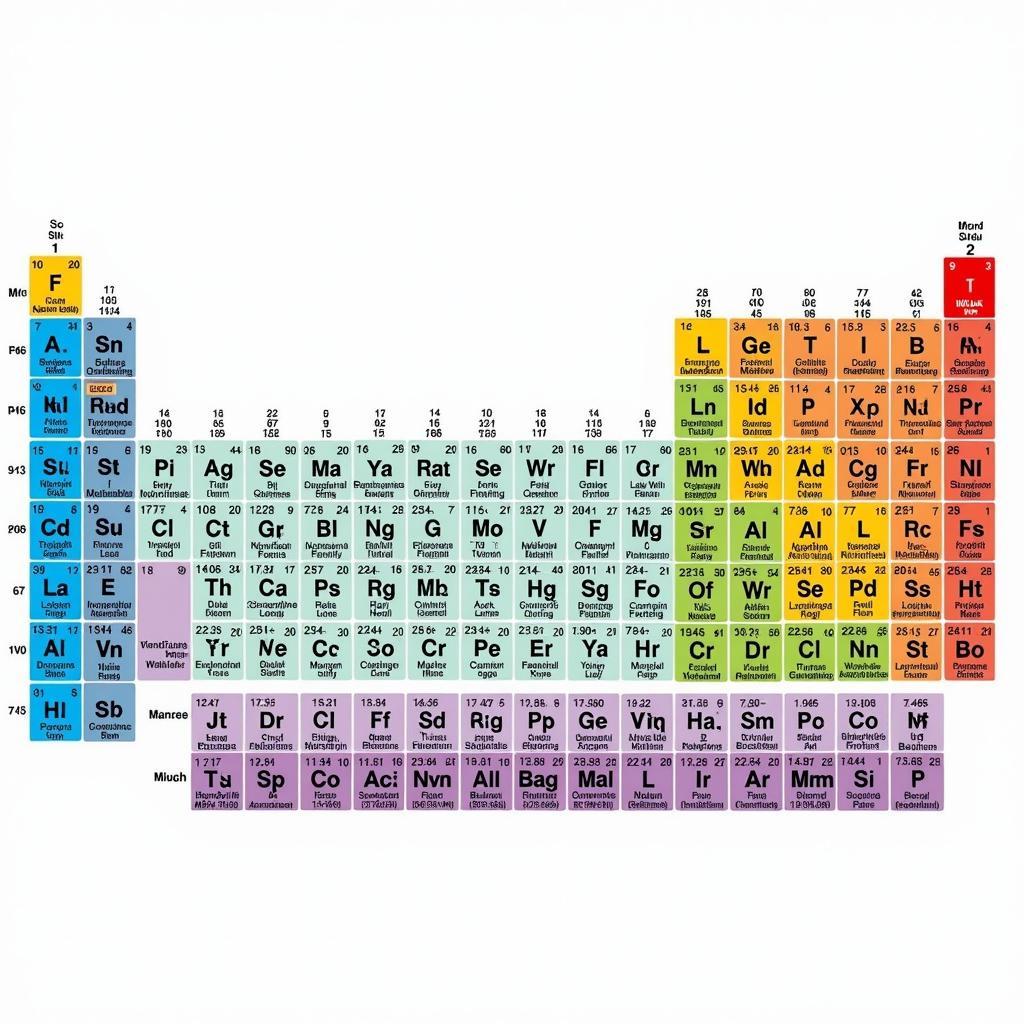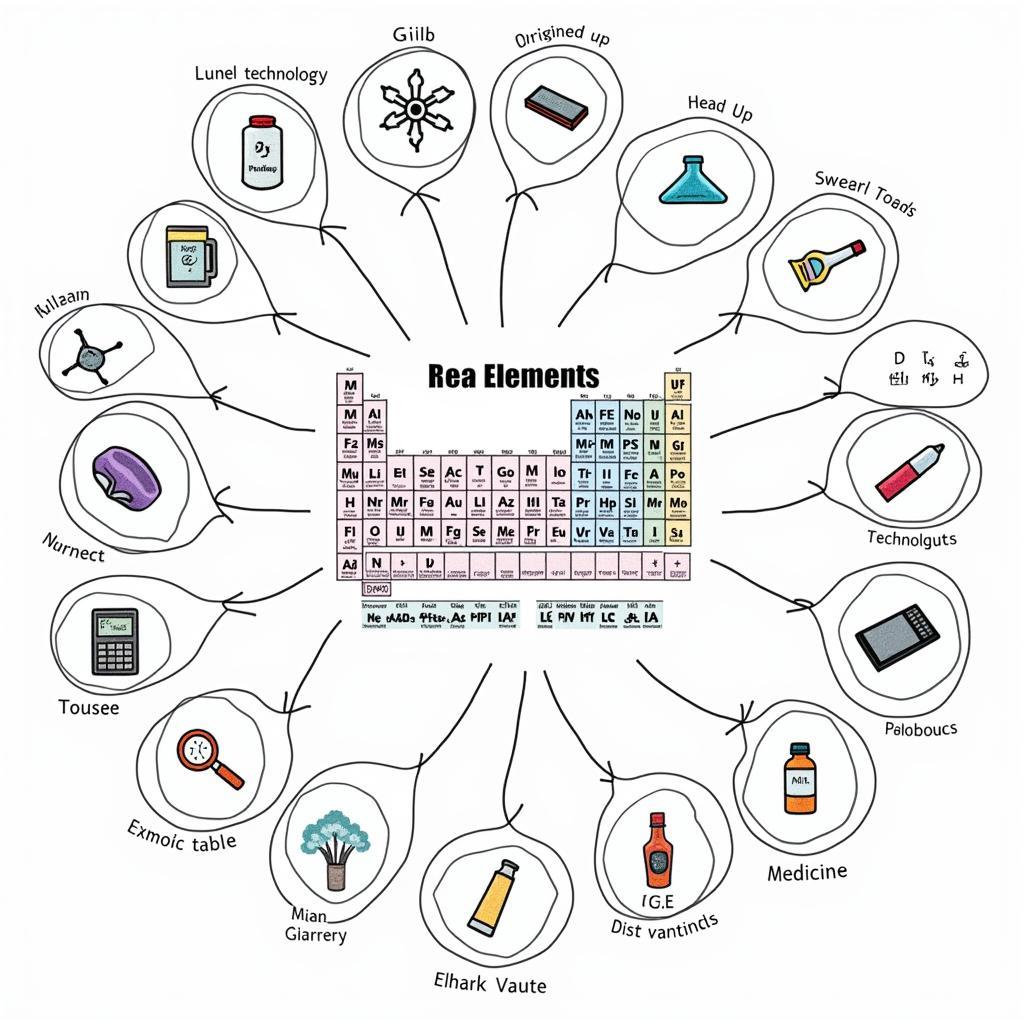The periodic table, a cornerstone of chemistry, can be even more empowering when understood in English. This guide provides a comprehensive overview of the “Bảng Hóa Học Tiếng Anh”, equipping you with the vocabulary and knowledge to navigate the world of elements effectively.
Decoding the “Bảng Hóa Học Tiếng Anh”: A Comprehensive Look
The periodic table, or “bảng hóa học tiếng anh”, organizes all known chemical elements based on their atomic number and properties. Understanding this arrangement is fundamental to grasping chemical reactions and behaviors. Each element on the table is represented by a unique symbol, often derived from its English or Latin name. Learning these symbols and names is crucial for effective communication in chemistry. For example, Hydrogen is represented by “H,” Oxygen by “O,” and Iron by “Fe” (from the Latin ferrum).  Detailed Periodic Table in English
Detailed Periodic Table in English
Mastering the “bảng hóa học tiếng anh” also involves understanding the periods (horizontal rows) and groups (vertical columns). Elements in the same group share similar chemical properties due to their identical outer electron configurations. For instance, the alkali metals (Group 1) are highly reactive due to their single valence electron. Conversely, the noble gases (Group 18) are inert because their outermost electron shells are full. This structured organization makes the periodic table a powerful tool for predicting element behavior.
Why Learn the Periodic Table in English?
học bảng phiên âm ipa can be a valuable skill in learning English pronunciation, which in turn can be helpful in learning the names of the elements. Learning the “bảng hóa học tiếng anh” unlocks a world of scientific literature, research, and collaboration. Many scientific journals and conferences primarily use English, and understanding the terminology is vital for participation. Moreover, studying chemistry in English opens doors to international educational and career opportunities. Imagine being able to collaborate with researchers from around the world, contributing to cutting-edge discoveries!
Navigating the Table: Key Terms and Concepts
Familiarizing yourself with key terms is essential for understanding the “bảng hóa học tiếng anh.” “Atomic number” refers to the number of protons in an atom’s nucleus, while “atomic mass” represents the average mass of an element’s isotopes. “Valence electrons,” the electrons in the outermost shell, dictate an element’s reactivity and bonding behavior. Mastering these terms allows for a deeper understanding of the table’s organization and the properties of each element.
“Professor Emily Carter, a renowned chemist at Princeton University, emphasizes the importance of a strong foundation in chemical nomenclature. She states, ‘A clear understanding of the periodic table in English is paramount for effective communication and collaboration in the global scientific community.'”
Practical Tips for Mastering the “Bảng Hóa Học Tiếng Anh”
học bảng nguyên âm tiếng anh may seem unrelated to chemistry but practicing your pronunciation will be helpful when studying the periodic table in English. Utilize flashcards, online resources, and interactive periodic tables to memorize element names, symbols, and properties. Practice writing chemical formulas and equations using English terminology. Engage in conversations with fellow chemistry enthusiasts to solidify your understanding and build confidence. “Dr. Michael Johnson, a chemistry educator with over 20 years of experience, advises, ‘Consistent practice and active engagement with the material are key to mastering the periodic table. Don’t be afraid to ask questions and seek clarification.'”
From Classroom to Career: The Impact of the Periodic Table
dịch tiếng anh chuyên ngành hóa học becomes easier when you’re familiar with the English names of elements and other terms. Understanding the “bảng hóa học tiếng anh” extends beyond the classroom, impacting various career paths. From medicine and pharmaceuticals to materials science and environmental engineering, a solid grasp of chemical principles is essential. By mastering the periodic table in English, you equip yourself with the fundamental knowledge needed to excel in these fields.  Applications of the Periodic Table in Daily Life
Applications of the Periodic Table in Daily Life
In conclusion, mastering the “bảng hóa học tiếng anh” is a valuable investment in your academic and professional future. By understanding the elements, their properties, and their relationships, you unlock a world of scientific knowledge and opportunity. Begin your journey today and explore the fascinating world of chemistry in English.
FAQ
- What is the significance of the periodic table?
- How are elements arranged on the periodic table?
- What are the different groups and periods in the periodic table?
- Why is it important to learn the periodic table in English?
- What are some effective strategies for memorizing the elements?
Need Help with the Periodic Table or Other Subjects?
cách học tiếng anh bằng điện thoại can be a great way to learn English and therefore helpful when studying the English periodic table. For support, contact us at Phone Number: 0705065516, Email: thptquangtrung@gmail.com. Or visit us at: NB tổ 5/110 KV bình thường b, P, Bình Thủy, Cần Thơ, Việt Nam. We have a 24/7 customer support team. Perhaps you’d also like to explore our resources on học bảng chữ cái hiragana.


